Northern Water broke ground on the Chimney Hollow Reservoir project in Aug. 2021. Since then the communications team has kept the public informed in new and innovative ways.
The construction of the Chimney Hollow Reservoir is a once-in-a-generation project, said Jeff Stahla, public relations officer for Northern Water.
The Chimney Hollow Reservoir Project will benefit nine cities, two water districts and a power provider including Broomfield, Platte River Power Authority, Loveland, Greeley, Longmont, Erie, Little Thompson Water District, Superior, Louisville, Fort Lupton, Lafayette and Central Weld County Water District.
“Big reservoirs like this don’t get built but every 20-, 30-years. And so we knew we had an opportunity, number one. Number two, for Northern Water this is really our first big reservoir that we have owned ourselves, that we’re building ourselves,” Stahla said.
In the 1930s, the Colorado-Big Thompson Project was started. The project was well documented with photos, slides and personal accounts, according to Stahla.
However, the technology then limited the project's ability to document the process in the same way the Chimney Hollow Project is being documented today.
Communications Specialist Rachel Stevens leads a team of eight to cover all the stories that come out of what is becoming the 90,000-acre-foot reservoir. She spends half of her time at the reservoir identifying stories that need to be told, she said.
The team is approaching the documentation with enthusiasm, Stahla said. They use a combination of social media, videos, newsletters and written materials to create an ongoing history of the making of the reservoir.
“I see it as our responsibility to share what is going on on-site with the communities around here and our participants,” Stevens said.
The Chimney Hollow Reservoir is located northwest of Carter Lake. It is not near highly-used roads so the public is unable to view it as they drive by, Stahla said. It’s location and public safety concerns make it difficult to bring large crowds to view the process. So the Northern Water communications team decided it was best to bring the stories to the public.
In its latest newsletter, Northern Water featured a virtual tour of the construction project. Project Engineer, Jeremy Deuto guides the tour through the main locations on site, from the tunnel — where water will flow in and out of the reservoir — to the deepest part of the dam.
The documentation goes beyond the project itself, it highlights the people who are working on it too. The March edition of the newsletter identifies the women who contribute to the project — from office support to running different aspects of the project.
Beyond documenting the process, Northern Water hopes to renew interest in the water supply issues.
“One of the pluses and minuses about what we do as a water provider is that we’ve been doing it so well for so long that it’s out of people’s minds. They turn on the faucet and water comes out and they don’t think about it. And so by showing everything that goes into a water supply project, we hope that increases people’s awareness about what it takes to have a water supply, a reliable water supply, in the semi-arid front range,” Stahla said.
When the project is finished, the communications team says they will publish a book that will combine all the information and memories collected through the process.
“We want to be able to show the next generation what it took to build this, so we are thinking long-term. I lean on the work of my predecessor to tell the story about the C-BT project (Colorado-Big Thompson project) … I have this visions that … after I am long gone, there will be people here who will appreciate the fact that we were proactively thinking about water supply … and we’ll have some documentation to show them,” Stahla said.
Correction: The reservoir will be 90,000-acre-feet, not 445.



